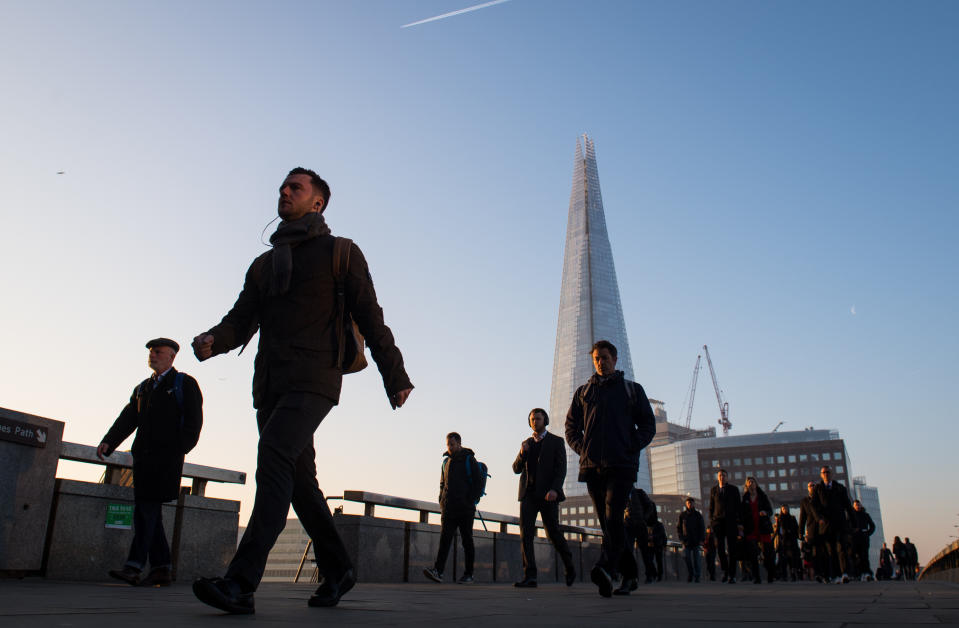UK unemployment rate on the rise as fears grow 'glory years over'

The unemployment rate has crept up in the UK, official figures reveal but some fear it could be the “beginning of the end” for Britain’s record jobs boom.
The number of people looking for work increased by 0.1 percentage point to 3.9% between April and June, according to Office for National Statistics (ONS) data published on Tuesday. Economists had predicted it would hold steady.
31,000 more people were unemployed in the three months to June, with a total of 1.33m people looking for work.
One expert had warned on Monday that “the glory years appear to be over,” as a leading business index recorded lower hiring intentions and official data showed Britain’s economy shrank in the second quarter.
But the UK employment rate also increased, returning to 76.1%, the joint-highest figure since records began in 1971.
The number of people in work rose by 115,000 to a record high 32.81m.
READ MORE: UK economy unexpectedly shrinks as GDP slides for first time in seven years
The apparent contradiction of rising employment and unemployment could be explained by a rise in people both looking for and finding jobs who were previously classed as ‘economically inactive.’
The ‘economically inactive’ category includes people not seeking paid employment, such as parents looking after children, disabled people unable to work and students.
For April to June 2019, the overall unemployment rate was 3.9% https://t.co/qPe00TIwYO pic.twitter.com/xggmXwv5Rt
— Office for National Statistics (@ONS) August 13, 2019
Britain has seen a period of jobs growth that has taken many economists by surprise amid poor productivity growth and Brexit uncertainty, with employment at levels not seen since the 1970s.
But critics have warned insecure, often lower-paid self-employment has driven a significant part of the growth, as well as employers preferring short-term cheap labour to costly investments that could help them expand or boost productivity.
Pawel Adrjan, an economist at jobs board Indeed, said the jobs market was “still surprisingly strong” despite the contraction in GDP in the second quarter.
“Pay growth continues to pick up as the employment rate ticks back up to a record high. But vacancies continue to fall - probably a more up-to-date indicator that risks abound. Vacancies are down year on year in most sectors at the economy,” he wrote on Twitter.
“Employment and wage growth figures don’t seem to be impact much by the slowing economy (yet!).”
READ MORE: Why experts think Britain’s record jobs boom could be coming to an end
Separate ONS research on Monday also suggested workers may be feeling increasingly insecure in their jobs, with expectations unemployment will rise this yaer higher than at any point since 2013.
Last month’s labour market figures saw the employment rate dip 0.1% on the previous quarter, the first time the percentage of people in work had fallen since mid-2018.
The actual number of people in employment had increased in last month’s figures for March to June by around 28,000, but the percentage figure fell as the size of the working-age population had grown faster.
Peter Hemmington, a partner at accountancy firm BDO, said of bleak survey data on Monday before the latest figures were announced: “This could be the beginning of the end of the strong employment market in the UK. It has remained one of the more resilient pillars of the UK economy, even in the face of Brexit.”
For April to June 2019, 76.1% of people aged 16 to 64 were in paid work, a joint record high https://t.co/7gm4TXDzhr pic.twitter.com/hIgR9j53vE
— Office for National Statistics (@ONS) August 13, 2019
READ MORE: UK retailers demand business rate cuts to save high street stores
*Correction: This story has been updated to reflect clarification that the UK unemployment rate was estimated at 3.9% on the quarter, with the rate at 0.1 percentage points higher rather than by 0.1%, which was previously reported.

 Yahoo Finance
Yahoo Finance 